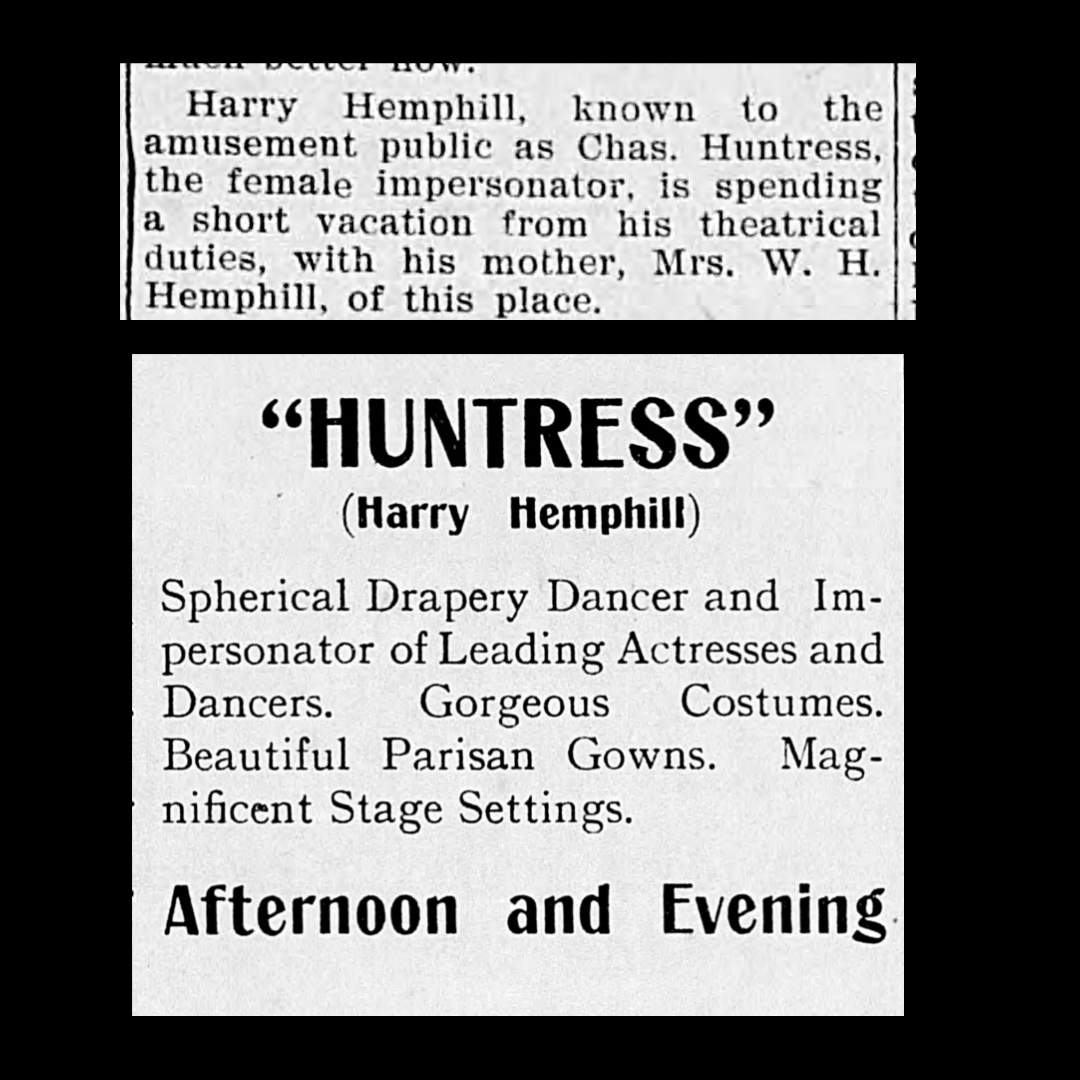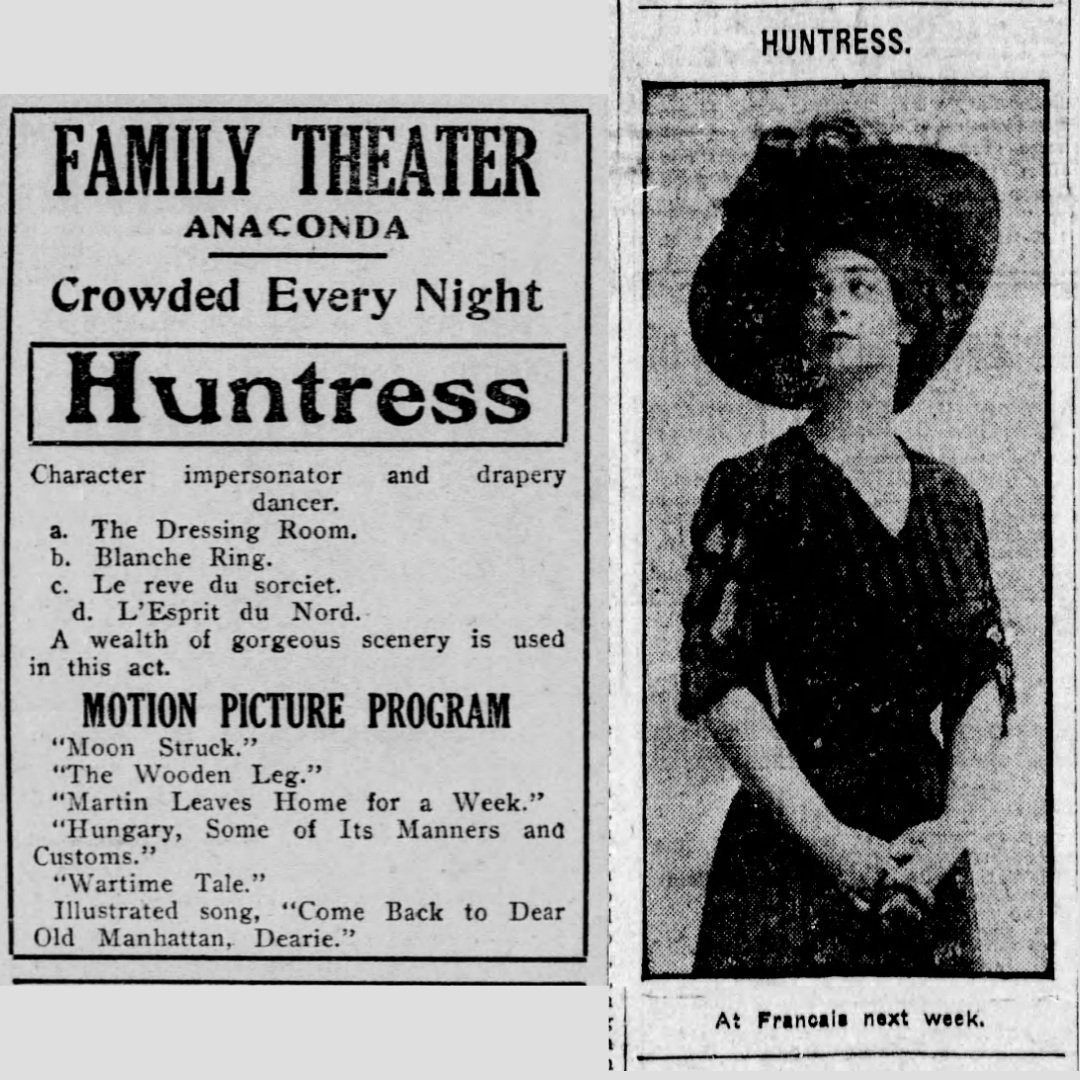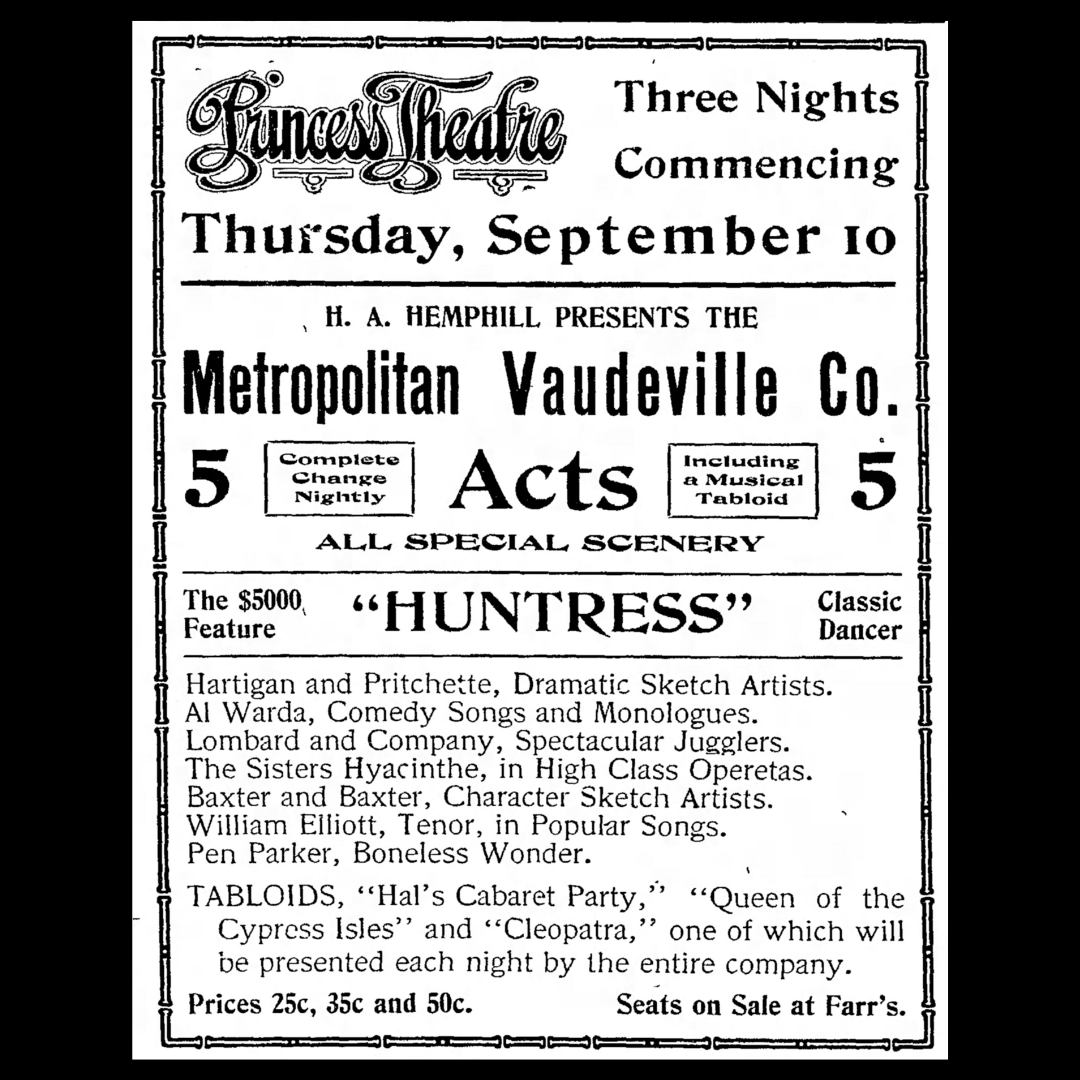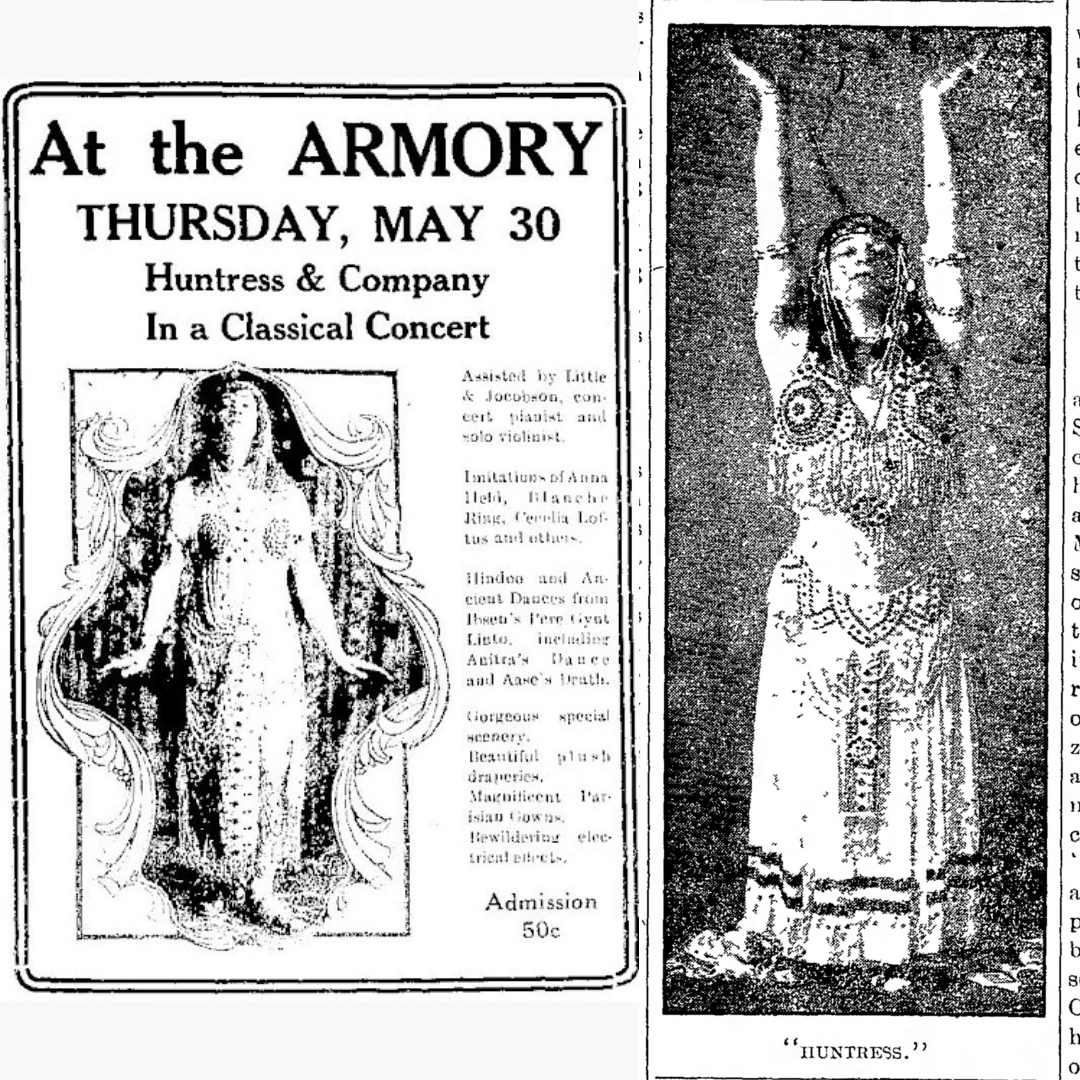Huntress
Huntress
This story is part of a series on “gender impersonators” on the early Vaudeville stages of Bellingham. Originally written and Published in the Betty Pages May 2023
“The Grand Theater has been playing to crowded houses all week and it is absolutely no exaggeration to say that the bill presented has never been surpassed and perhaps never equaled on the Pacific Coast. It is no idle boast to say, ‘To see the best in the land you must patronize the Grand,’” gushed the Bellingham Herald in August of 1905. The theatrical bill included a performer with the fabulous stage name of “Huntress” in a “spherical electrical feature.”
A little digging revealed “Huntress” was born Harry Hemphill in 1876 in rural Iowa. After completing 8th grade, Harry apprenticed at a local newspaper. Often in the news himself, the papers described Harry singing at church entertainments, organizing a string band and hosting a masquerade party. Though popular at his newspaper job, Harry aspired to the stage.
Harry “commenced to make a wardrobe for a female impersonation song and dance act” with the help of a young girl of the town. At first Harry’s mother objected to his stage aspirations, but she eventually consented and helped prepare his wardrobe. Harry’s father deserted the family and Harry supported his mother with his earnings.
At first working for pennies, Harry got his start with a traveling “medicine show.” He took the stage name “Charles Huntress,” later dropping “Charles” to have one of the fiercest stage names of the times.
In between seasons, Harry would return to his hometown and vicinity to teach classes in dance and embroidery, both in which he excelled. Harry applied his skills to his wardrobe, hand embroidering his gowns and even making his own lace. Harry taught embroidery to “hundreds of La Crosse’s most prominent women… who doubtless remember with pleasure the lessons received at the hands of the nimble-fingered instructor.”
“Huntress” began touring the major vaudeville circuits and garnered favorable press. His act eventually carried a train carload of special scenery, lighting equipment and trunks full of costumes.
Like many drag artists today, Huntress impersonated famous singers, dancers, and actresses of the times. His dances were inspired by, and skills compared to the likes of Gertrude Hoffman, Ruth St. Denis, Adeline Genée and Loie Fuller. Fuller, a pioneer of modern dance and use of theatrical lighting techniques, is credited as the originator of the “serpentine dance,” imitated by many vaudevillians over the years. The dance involved manipulating yards of silk fabrics, creating “serpentine” waves, illuminated by new-fangled electric lighting creating trippy optical illusions.
Huntress’ signature act utilized the flowing draperies and lighting effects and took it up a notch by also balancing on a large ball. Huntress’ “spherical electric feature” was called “L’esprit du Nord” (spirit of the north) and described as “a dance of the polar regions.”
The stage “transformed into a beautiful arctic setting showing a sea of icebergs in gorgeous colors and glitter, foil and spangles.” While rolling the “snowball” with his feet Huntress “manipulated white silken fabric in graceful billows.”
In 1911 Harry used his earnings to renovate the cottage in Iowa where his mother lived and was his home base. The local paper remarked “it only shows what can be done when one has a taste for pretty things and is not afraid to break away from old conventions.”
In 1913 Huntress toured Australia and New Zealand with a companion identified only as “George,” the trip documented in a series of letters sent to the hometown newspaper where he once worked. Harry described a big dance aboard the ship on its return journey, for which he organized an elaborate show featuring a dozen vaudevillians on board. Harry wrote: “I, in all my dazzling glitter and glare of the Orient, was Queen of Sheba. When the Royal procession entered the hurricane deck we were greeted with rounds and rounds of applause and the whole thing was a grand success.”
Upon return, Harry formed his own Metropolitan Vaudeville Company with which he toured for a few more years before retiring in 1916 at age 40, after more than 20 years on the stage. Harry moved back home with his mother and opened a school of dance christened “Hemphill’s Egyptian Temple.”
After his mother passed away in 1922, Harry planned a “summer home” for his dance academy with classical architecture, a sunken garden and an outdoor “Greek Theater,” though it is unclear whether it ever materialized. In 1925 at age 48, Harry married dance teacher Anna Wenquist, and the pair relocated to San Diego, California. The pair opened another school of dance, and were respected members of the dance community there for more than 20 years. Harry continued working with textiles, local galleries exhibiting his weaving.
Harry passed away in 1954, at age 78. His hometown newspaper reported on his death, recalling him as a great artist and a “prime favorite with many households here three decades ago.”
As a psychological archetype, “the Huntress” is said to personify the independent female spirit, representing autonomy and pursuit of life of one’s choosing. At the turn of the 20th century, a boy from small town Iowa chose the stage name “Huntress” and followed his dreams, using his many artistic skills to find success. Imagine Huntress rolling on a sparkling snowball across the vaudeville stage of the Grand Theatre in Bellingham in 1905. Let the story of Harry Hemphill be an inspiration. Raise a horn-shaped cup to the memory and spirit of Huntress!
You can help support the Betty Pages by subscribing on Patreon here: https://www.patreon.com/TheBettyPages
For further reading on Harry “Huntress” Hemphill see Frank D. Myers 2016 Blog Post: Huntress: Chariton's gender-bending superstar










Percy teamed up with another female impersonator who went by Lou Lalonda. Percy and Lou were billed at Bellingham’s Grand Theater on Holly Street in September of 1905. At the time of their performance in Bellingham, papers described them as “two pretty young ladies who easily win applause.”